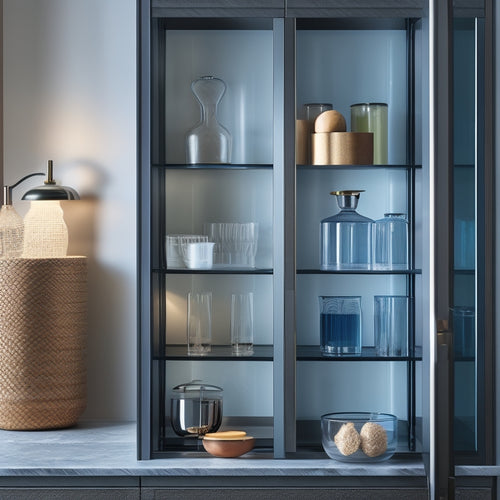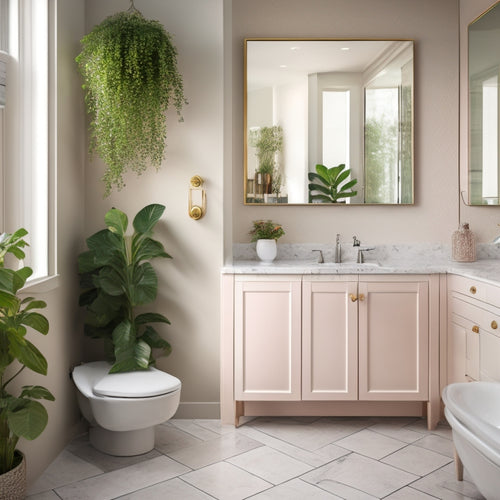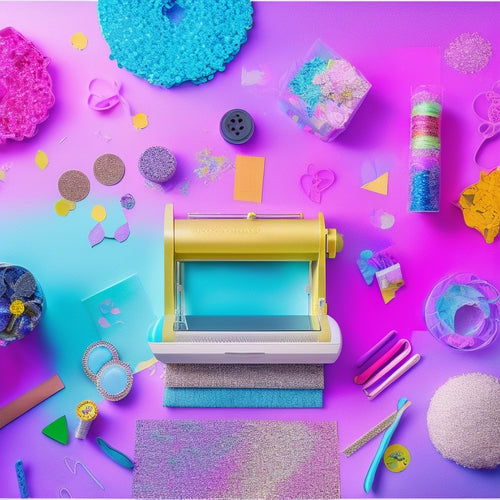
Flawless Bathroom Marble Countertop Installation
Share
To achieve a flawless bathroom marble countertop installation, you'll need to prepare the workspace by removing outdated fixtures and ensuring a sturdy foundation. Choose a marble type that suits your budget and desired aesthetic, considering factors like durability and maintenance. Measure your countertop accurately, creating a precise template to avoid mistakes. Cut and shape the marble with safety precautions, employing techniques like sawing and sanding. Install the countertop, ensuring a level and secure fit, then seal and protect it with high-quality products. Finally, inspect your work, making adjustments as needed, and get ready to enhance your bathroom's style to new heights - but first, tackle the critical details that will make all the difference.
Key Takeaways
- Ensure a sturdy foundation and assess plumbing system to prevent water damage and ensure successful installation.
- Choose the right marble type, variety, and finish considering durability, maintenance, and budget to achieve the desired aesthetic.
- Measure countertop dimensions accurately and create a precise template to avoid mistakes and ensure a flawless fit.
- Apply high-quality adhesive and sealant, and follow manufacturer's instructions to ensure a secure and long-lasting installation.
- Conduct a thorough quality control inspection to identify and address any flaws or imperfections before finalizing the installation.
Preparing the Bathroom for Marble
The bathroom, a space where functionality meets aesthetics, must be thoroughly prepared before introducing the luxury of marble countertops. You're about to enhance your bathroom's style, but first, it's time to get your hands dirty.
Remove those outdated fixtures, including faucets, sinks, and vanities. Yes, it's a formidable task, but trust us, it's worth it. You'll be amazed at how a fresh start can revitalize the entire space.
Next, assess your plumbing system to verify it's compatible with your future marble countertops. Check for any leaks, corrosion, or worn-out pipes that might compromise the integrity of your new installation.
Don't risk water damage or structural issues down the line. Take this opportunity to upgrade your plumbing if necessary. Remember, a sturdy foundation is key to a successful marble countertop installation.
Choosing the Right Marble Type
When selecting a marble type for your bathroom countertop, you'll need to contemplate two key factors: marble slab options and marble color selection.
You'll want to choose a slab option that suits your design goals, whether it's a standard, premium, or exotic slab.
Marble Slab Options
Beyond aesthetics, choosing the right marble type for your bathroom countertop involves pondering factors like durability, maintenance, and budget.
You'll want to select a marble that fits your lifestyle and meets your needs.
When it comes to marble slab options, you'll encounter various types, each with its unique characteristics.
For instance, Carrara marble is known for its soft, feathery patterns and is often preferred for its subtle, refined look.
On the other hand, Calacatta marble boasts bold, striking veins, making it a popular choice for those seeking a dramatic statement.
Beyond the type of marble, you'll also need to contemplate the finish.
A polished finish will give your countertop a high-gloss, reflective sheen, while a honed finish will provide a matte, subtle appearance.
Additionally, edge profiles can greatly impact the overall look of your countertop.
From simple eased edges to ornate ogee profiles, the options are endless.
Marble Color Selection
Picking the perfect marble color for your bathroom countertop can make or break the overall aesthetic of the space.
You're not just choosing a color, you're setting the tone for the entire room. Marble color selection is an art that requires consideration of color psychology, popular trends, and your personal style.
When it comes to color psychology, certain shades can evoke emotions and moods. For example, white and cream-colored marbles can create a sense of calmness and serenity, while darker shades like black or dark gray can add drama and sophistication.
On the other hand, popular trends can influence your decision. Right now, neutral tones like Carrara and Calacatta are all the rage, but if you're feeling bold, you could opt for a bolder choice like Emerald Green or Rosso Levanto.
Ultimately, the right marble color for you'll depend on your bathroom's unique style and ambiance.
Take your time, do your research, and don't be afraid to ask for samples or advice from a professional.
With the right marble color, your bathroom will be altered into a stunning oasis that's both beautiful and functional.
Measuring and Templating the Countertop
You've reached the critical stage of measuring and templating the countertop, where accuracy is paramount.
One misstep here can lead to a world of trouble down the line. So, take a deep breath, grab your tape measure, and let's get started!
3 Critical Considerations for Measuring and Templating
- Countertop dimensions: Measure the length, width, and any obstructions, such as sinks or faucets.
Record these measurements to the nearest 1/16 inch to guarantee a precise fit.
- Template accuracy: Create a template that mirrors the countertop's shape and size.
This will serve as a guide for the marble fabricator, guaranteeing the finished product fits like a glove.
- Account for irregularities: Identify any irregularities in the wall or cabinet layout that may affect the countertop's fit.
Factor these in when creating your template to avoid costly mistakes.
Cutting and Shaping the Marble
With precision-cut templates in hand, it's time to convert raw marble into a stunning countertop. You're about to release your inner sculptor and excel in marble cutting techniques.
Don your safety gear, including gloves, goggles, and a dust mask, because things are about to get real.
Fire up your saw or waterjet cutter, depending on the complexity of your design, and start cutting the marble slabs into manageable pieces. Use a combination of shaping tools, such as diamond-edged blades, routers, and sanders, to refine the edges and surfaces.
Remember to work methodically, as marble is unforgiving – one misstep, and you'll be left with a costly mistake.
As you cut and shape the marble, keep in mind the desired finish and texture. Will it be high-gloss, honed, or matte?
The type of finish you choose will influence your marble cutting techniques and shaping tools. Take your time, stay focused, and you'll be rewarded with a breathtakingly beautiful countertop that's sure to impress.
Installing the Marble Countertop
Every inch of your beautifully crafted marble countertop is now ready to be carefully installed. The moment of truth has finally arrived, and with the right installation tools, you'll be enjoying your new countertop in no time.
To guarantee a successful installation, remember these essential steps:
-
Prepare the surface: Verify the cabinets and walls are level, and the surface is clean and dry.
-
Apply the adhesive: Use a high-quality adhesive specifically designed for marble, following the manufacturer's instructions.
-
Align and secure: Carefully position the countertop, confirming it's level and secure, and use the necessary fasteners to hold it in place.
As you complete the installation, keep in mind that proper countertop maintenance will be vital to maintaining your marble's beauty.
With the right care, your new countertop will remain stunning for years to come.
Sealing and Protecting the Marble
Regularly, marble countertops require sealing to maintain their elegance and protect them from stains and etching.
You'll want to apply a high-quality sealant to create an invisible barrier that prevents spills and splatters from penetrating the stone. When it comes to marble maintenance tips, sealing is key.
It's crucial to choose a sealant specifically designed for marble, as it will provide the necessary protection without altering the stone's appearance.
Apply the sealant according to the manufacturer's instructions, making sure to cover the entire surface evenly. You may need to apply multiple coats, allowing each coat to dry before applying the next.
Once the sealant is fully dry, your marble countertop will be protected from stains and etching.
To maintain the protective coatings, clean your marble countertop regularly with a mild detergent and avoid using abrasive cleaners or scrubbers.
By following these steps, you'll be able to enjoy your beautiful marble countertop for years to come.
Final Touches and Quality Control
Upon completing the sealing process, your attention turns to the finer details of the installation.
You're almost there, but don't rush through this vital step – it's time for the finishing touches. This is where you ascertain every aspect of the marble countertop meets your high standards.
To confirm a flawless installation, perform the following quality checks:
-
Inspect the edges: Verify that the edges are polished to perfection and free of any scratches or imperfections.
-
Check the sink and faucet: Confirm that the sink and faucet are properly installed and aligned, with no signs of leaks or water damage.
-
Verify the overall look: Step back and admire your handiwork. Ascertain the marble countertop is level, the seams are tight, and the entire installation looks stunning.
Frequently Asked Questions
Can I Install a Marble Countertop Myself, or Do I Need a Professional?
You're wondering if you can tackle a marble countertop installation solo? While it's possible with DIY tips and the right installation tools, we wouldn't recommend it - unless you're a expert of precision and patience, that is!
How Do I Prevent Etching on My New Marble Bathroom Countertop?
You're finally living the high life with your new marble bathroom countertop, but etching is the ultimate party crasher. Prevent it by wiping up spills pronto, using coasters, and applying a marble care sealant - your countertop will thank you (and so will your social life)!
Are Marble Countertops Heat-Resistant, or Do I Need Special Precautions?
You're wise to wonder about heat resistance! Marble countertops can withstand moderate heat exposure, but you'll still need to take precautions, like using trivets and mats, to prevent thermal shock and maintain their elegance.
Can I Use Marble Countertops in a Bathroom With High Humidity?
You wonder if marble countertops can thrive in a humid bathroom; surprisingly, they can, but you'll need to commit to regular marble maintenance tips, like sealing and drying, to combat humidity effects and prevent etching.
Are Marble Countertops Suitable for Bathrooms With Heavy Usage?
You're wondering if marble countertops can handle heavy bathroom traffic? Well, with regular marble maintenance tips, they can! Just be prepared for extra TLC, and consider incorporating them into your bathroom design trends, like a chic, low-maintenance oasis.
Conclusion
You've finally achieved the ultimate bathroom status symbol: a flawless marble countertop installation. The irony? It's so perfect, it's almost... boring. No more imperfections to distract from the stunning veining patterns, no more excuses to delay that bathroom selfie. Your new countertop is a work of art, a harmony of elegance and sophistication. Now, go ahead, take a deep breath, and bask in the glory of your handiwork.
Related Posts
-

Space-Efficient Glass Door Cabinet Solutions
Looking for space-efficient glass door cabinet solutions? You're in for a treat! These stylish cabinets maximize your...
-

Stylish Corner Cabinet Ideas for Bathrooms
Looking to enhance your bathroom with stylish corner cabinets? You can maximize space and improve aesthetics at the s...
-

Unleash Your Creativity: Cricut Projects Galore
Ignite your creativity with a Cricut machine, where beginners can start with fundamental projects like vinyl decals a...


